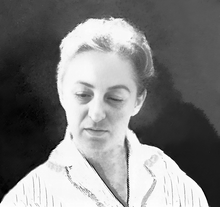Věra Lišková (20 September 1924, Prague – 7 June 1985, Prague) was a Czech glass artist. She is known for pioneering the use of borosilicate glass or pyrex in glass art.


Education and career
editLišková studied at the State Graphic School in Prague until it closed due to World War II. She then studied at the School of Applied Arts in Prague and graduated in 1949.[1]
As a student in 1947, she applied for a scholarship offered by the J. & L. Lobmeyr in Kamenický Šenov. Under the guidance of Stephan Rath, the nephew of the company's founders, she created a thin-walled drinkware set adorned with engraving.[1] The set received an award from the Ministry of Industry and became part of the collection of the Museum of Decorative Arts in Prague.[2] Her glass, displayed in the first solo exhibition at the Museum of Modern Art in New York, was acquired for the museum's collections by the then-director Kaufmann. Until 1959, Lišková had a total of five solo exhibitions in this museum.[3]
Lišková acquired Gočár's studio at 72 Mánesova Street in Vinohrady, where from the mid-60s onwards, she crafted sculptures from technical glass shaped over a gas flame. She began making borosilicate glass sculptures in the late 1966. Some of her designs were also brought to life by glass blowers and František Kirchner.[4] Her work was instrumental in recognizing glass as an artistic medium.[5][1]
Art
editLišková is known for pioneering the use of borosilicate glass or pyrex in glass art.[6] Borosilicate glass is traditionally used in manufacturing scientific apparatus such as test tubes and beakers.[7][8][9]
Lišková is best known for large, abstract sculptures that are made of clear glass. Her strong yet delicate sculptures feature intricate patterns. Most of her works feature spiny, sharp designs and clean lines.[5]
Selected works
editReferences
edit- ^ a b c "Věra Lišková". Voices in Studio Glass History. Retrieved 1 July 2022.
- ^ Petrová, Sylva (2001). České sklo. Praha: Gallery. pp. 33, 68. ISBN 978-80-86010-44-1.
- ^ "Vera Lisková". MOMA. Retrieved 2024-01-18.
- ^ Hlaveš, Milan; Pospíšil, Jiří; Koenigsmarková, Helena; Klivar, Miroslav; Mladek, Meda; Museum Kampa, eds. (2016). 7+1 mistři českého skla: = 7+1 masters of Czech glass. Praha: Museum Kampa - Nadace Jana a Medy Mládkových. p. 58. ISBN 978-80-87344-32-3.
- ^ a b "Famous Glass Blowers & Glass Artists [Updated]". Working the Flame. 23 April 2020. Retrieved 1 July 2022.
- ^ "Collection Search | Corning Museum of Glass". cmog.org. Retrieved 1 July 2022.
- ^ Conroy, Sarah Booth (7 June 1981). "A Glass Act of Seduction". Washington Post. Retrieved 1 July 2022.
- ^ "Anthem of Joy in Glass". cmog.org. Corning Museum of Glass. Retrieved 1 July 2022.
- ^ a b "Věra Lišková". Voices in Studio Glass History. Retrieved 1 July 2022.
- ^ "Lišková Věra (1924–1985): Závěsná váza". sypka.cz (in Czech). Aukční dům Sýpka. Retrieved 1 July 2022.
- ^ "A Vera Lisková cut and engraved glass 'Zodiac Beaker', Kamenický Senov, circa 1947-48". Bukowskis. Retrieved 1 July 2022.
- ^ "Artnet Vera Liskova". artnet.com. Retrieved 1 July 2022.
- ^ "Lot 960: Widder Liskova Czech Glass Ram Aries modern". invaluable. Retrieved 1 July 2022.
- ^ "Sept. 4 Art Minute: Věra Lišková, Echo". The Toledo Museum of Art. 4 September 2017. Retrieved 1 July 2022.